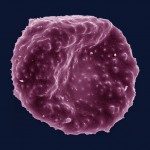Présentation
The protozoan pathogen P. falciparum undergoes antigenic variation to establish persistent blood stage infection. Several clonally variant gene families undergo antigenic variation in P. falciparum and are expressed during blood stage infection at the surface of infected erythrocytes. One family encoded by 60 var genes expresses the major virulence adhesion surface molecule (called P. falciparum Erythrocyte Membrane Protein 1, PfEMP1) causing severe malaria (capillary blockages in the brain and other organs mediated by infected erythrocytes). The ‘clogging’ of blood vessel by infected RBC is strongly linked to P. falciparum pathogenesis. One peculiarity of this mechanism is that only one member of the 60 var genes is expressed (monoallelic expression). Switching expression between the 60-member var gene family avoids parasite immune clearance and prolongs the period of infection and transmission to the mosquito (for review see Scherf et al., 2008 Ann. Review Microbiol.; Scherf et al., 2008 Cell). Distinct histone methylation determines the fate of var gene activity: Lopez-Rubio, JJ., Mancio Silva, L., Zhang, Q., Guizetti, J., Scheidig, C., Claes A. After having demonstrated the key role of distinct types of histone methylation marks in var gene activation (H3K4me3), poised state (epigenetic memory) (H3K4me2/3) and silencing (H3K9me3)(Lopez-Rubio et al., 2007 Mol. Micro.) we showed for the first time, by using genome-wide ChIP analysis, that clonally variant gene expression share common epigenetic control mechanisms (Lopez-Rubio et al., 2009 Cell Host Microbes). In a very recent collaborative work of the L. Miller (NIH) laboratory, we participated in a study that revealed the key role of another histone methylation mark at position H3K36. Gene knock out of the corresponding SET gene (termed PfSETvs), results in the transcription of virtually all var genes analysed in the single parasite nucleus (Jiang et al., 2013 Nature). H3K9me and H3K36me are crucial for the default silencing of var genes, however, the interplay between the histone methyltransferases involved in this process remains to be determined. We investigated whether nuclear pores associate with the var gene expression site. To this end, we studied the nuclear pore organization during the asexual blood stage using a specific antibody directed against a subunit of the nuclear pore, P. falciparum Nup116 (PfNup116). Ring and schizont stage parasites showed highly polarized nuclear pore foci, whereas in trophozoite stage nuclear pores redistributed over the entire nuclear surface. Co-localization studies of var transcripts and anti-PfNup116 antibodies showed clear dissociation between nuclear pores and the var gene expression site in ring stage. Our results indicate that P. falciparum does form compartments of high transcriptional activity at the nuclear periphery, which are, unlike the case in yeast, devoid of nuclear pores (Guizetti et al., 2013 Euk. Cell). We will investigate the biochemical nature of the expression site using new technologies. New technology development: Lopez-Rubio JJ., Ghorbal M., McPherson C., Guizetti J., Claes A., Scheidig C. Given the total absence of knowledge about the nature of the var expression site, we are developing in vivo promoter tagging techniques. We have started to develop the TetO elements and TetR fused to GFP to pull down the active var gene to study its molecular chromatin composition and to develop specific markers for this expression site. The very recent CRISPR/Cas9 system developed in the unit by the JJ. Lopez-Rubio team provides a novel powerful tool for genome editing and will be explored for various projects in the unit. A second inducible system to down-regulate mRNA based on a riboswitch element inserted at the 3’ UTR has been tested and appears to be a suitable tool to study essential gene function.

